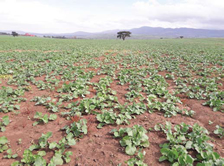Canola agronomy and nutrition
 David Jones A Broadacre Specialist Agronomist at Crop Nutrition Laboratories Ltd.
David Jones A Broadacre Specialist Agronomist at Crop Nutrition Laboratories Ltd.
Canola is now a mainstream crop in Kenya, and for good reasons, it is profitable in its own right, improves the yield of following cereal crops, and givesexcellentcontrol of persistent grassweeds such as Bromes, Eleusine and Setaria. However, success with canola requires careful management however and close attention to detail to maximise its potential.
As with all crops, the establishment phase is critical. The small seed requires an accurate planting depth, and planting below 3cm will severely impair germination. The low seed rate, as often as low as 2.5 kg per hectare, means that the planter has to be accurately calibrated and the seedbed must be level to ensure even germination.

Dig a soil pit and look for signs of compaction before planting, and loosen with a chisel plough or subsoiler if necessary. It is important to level the ground afterwards, to conserve moisture and to allow the planter to achieve an even depth. At present the only effective Broad Leaved Weed herbicides are pre emergence, so a level seedbed also improves the effectiveness of the spray.
Thousand Seed Weight varies substantially for canola, from less than 4 grams per 1,000 seeds to more than 6 grams. Although Canola can compensate by producing large numbers of buds, plant population is very important as it affects maturity, disease pressure and final yield. For this reason I always advocate checking the seed weight, to plant by seeds per metre square, rather than by weight.It is very important to calibrate for this, to plant 50-60 seeds per square metre.
Overly thick crop canopies use light and nutrients less efficiently, and have higher disease pressure, and too thin a plant population results in lost yield and allows space for weeds to grow.
Seedbed fertiliser is important to get the crop away quickly from pests such as Flea Beetle and Millipedes. Always carry out a soil test several weeks before land preparation to determine liming and fertiliser requirements. I always advocate placing some nitrogen in the seedbed, and applying the rest by the 5 leaf stage.
Canola has a huge demand for Sulphur (S); the crop can remove up to 10kg S per ton of yield, so a 4 t/ha crop will remove 40kg of S. Compared to this wheat removes just 1.5 kg of S per ton of yield. Ammonium Sulphate is a useful and cost-effective product for applying Sulphur, but it must be applied before stem extension, and should be spread accurately which can be a challenge.
In most countries a two-spray fungicide program is used. However we are currently investigating whether this is both necessary & effective in Kenya, particularly against the key disease which is Sclerotinia. Foliar micronutrients can also be required in low doses. Canola is particularly sensitive to boron deficiencies, and it can be deficient in many Kenyan soils. Boron affects pollen production and seed set. Leaf tissue analysis is important to avoid spending money on unnecessary trace elements.
Monitor the crop right up to maturity for caterpillars such as Diamond Back Moth Larvae, and Mealy Cabbage Aphids, both of which can cause serious damage and yield loss, and apply an approved insecticide if required. Be careful to time the spray to protect pollinators such as bees – evening is safest.
Harvesting canola with a combine harvester crop requires care, and many fields – especially in shambas with lots weeds – will benefit from spraying off (desiccating) with glyphosate 2-3 weeks before harvest. Timing is important so speak to an agronomist.
Finally, set up the combine harvester correctly to maximize the yield and quality of the harvested seed:
• Lift the reel well up and match groundspeed to avoid shattering the pods
• Don’t drive too fast
• If possible, use a side knife to stop the crop wrapping around the side of the header
• Shut the concave right down
• Reduce the fan speed as low as possible, before the sample becomes dirty
• Set the sieves as wide as possible, before the sample becomes dirty
• Keep a low drum speed to avoid small debris getting into the sample.
David Jones is the Broadacre Specialist Agronomist at Crop Nutrition Laboratories Ltd. Crop Nuts offers a full soil and leaf testing program for your cereals, as well as Consultant Agronomy Services for total crop husbandry.